In this post we will comprehensively discuss how to build a 500 watt inverter circuit with an integrated automatic battery charger stage.
Further in the article we will also learn how to upgrade the system for higher loads and how to enhance ot into a pure sine wave version.
This 500 watt power inverter will convert a 12 V DC or 24 V DC from a lead acid battery to 220 V or 120 V AC, which can be used for powering all types of loads, right from CFL lights, LED bulbs, fans, heaters, motors, pumps, mixers, computer, and so on.
Basic Design
An inverter can be designed in many different ways, simply by replacing the oscillator stage with another type of oscillator stage, as per user preference.
The oscillator stage is basically an astable multivibrator which could be using ICs or transistors.
Although an astable based oscillator can be designed in various ways, we will use the IC 4047 option here since it is a versatile, accurate and a specialized astable chip designed specifically for applications like inverers.
Using IC 4047
Making any inverter using the IC 4047 is probably the most recommended option due to high accuracy and readability of the IC. The device is a versatile oscillator IC which provides a dual push pull or flip flop output across its pin10 and pin11, and also a single square wave output at pin13.

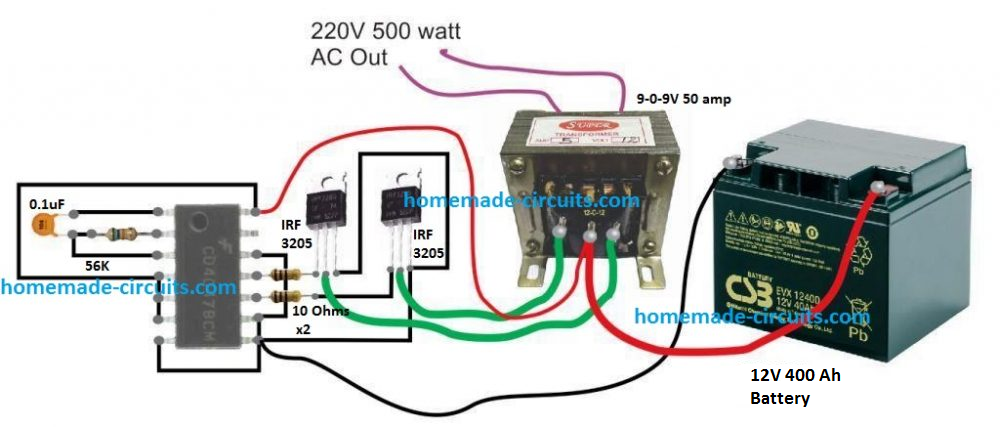
A basic 500 watt inverter with a square wave output can be as simple as above to build. However, to upgrade it with a battery charger we may have to employ a charger transformer rated appropriately as per the battery specifications.
Before learning the charger configuration let's first get acquainted with the battery specification required for this project.
From one of our previous post we know that the more appropriate charging and discharging rate of a lead acid battery should be at 0.1C rate or at a supply current that's 10 time less than the battery Ah rating. This implies that to get a minimum of 7 hours back up at 500 watt load, the battery Ah could be calculated in the following manner
Operational current required for a 500 watt load from a 12V battery will be 500 / 12 = 41 Amps approximately
This 41 amps needs to last for 7 hours, implies that the battery Ah must be = 41 x 7 = 287 Ah. However, in real life this will will need to be at least 350 Ah.
For a 24 V battery this may come down to 50% less at 200 Ah. This is exactly why a higher operational voltage is always advised as the wattage rating of the inverter gets on the higher side.
Using 24 V Battery
In order to keep the battery and the transformer size smaller and cables thinner, you may want to use a 24 V battery for operainf the proposed 500 watt design.
The basic design would remain as is, except a 7812 IC added to the IC 4047 circuit, as shown below:
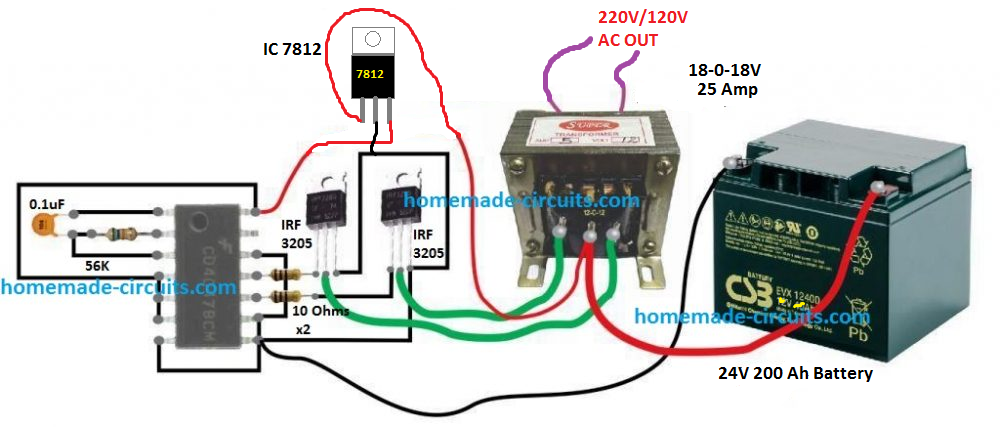
Schematic Diagram

Battery Charger
To keep the design simple yet effective, I have avoided the use an automatic cut off for the battery charger here, and have also ensured a single common transformer is used for the inverter and the charger operations.
The complete circuit diagram for the proposed 500 watt inverter with battery charger can be seen below:
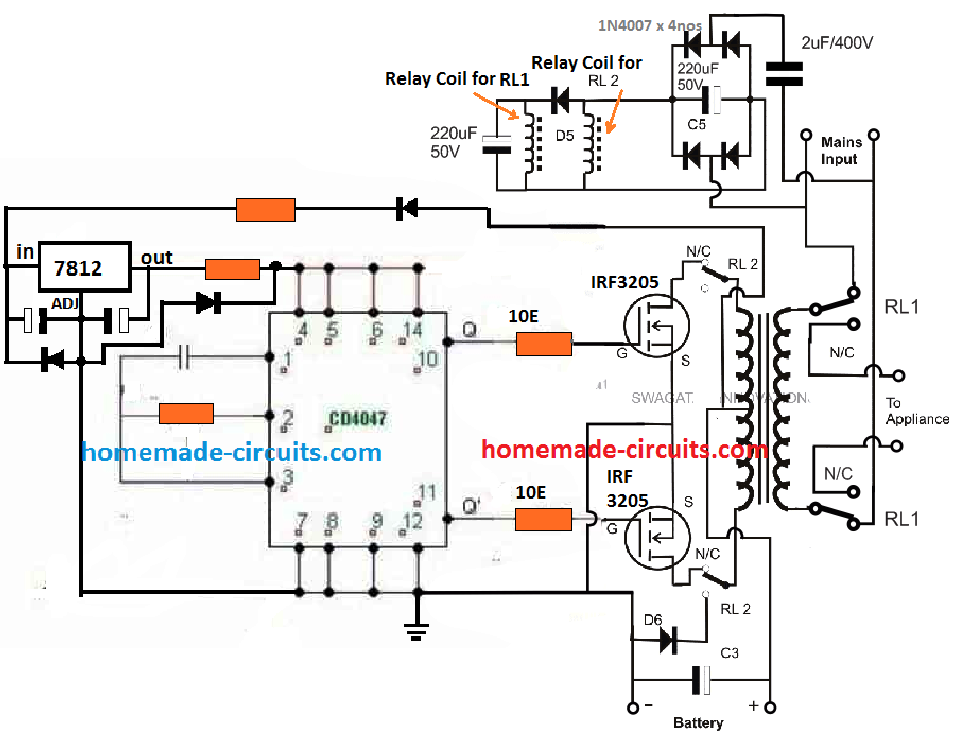
The same concept has been already elaborately discussed in one of the other related posts, which you can refer to for additional information.
Basically, the inverter uses the same transformer for charging the battery and for converting the battery power to 220 V AC output. The operation is implemented through a relay changeover network, that alternately changes the transformer winding to charging mode and inverter mode.
How it Works
When grid mains AC is not available, the relay contacts are positioned at their respective N/C points (normally closed). This connects the drains of the MOSFETs with the transformer primary, and the appliances or the load connect with the secondary of the transformer.
The unit gets into inverter mode and begins generating the required 220V AC or 120 V AC from the battery.
The relay coils are powered from a simple crude transformerless (capacitive) power supply circuit using a 2uF / 400V dropping capacitor.
The supply is not required to be stabilized or well regulated because the load is in the form of the relay coils which are quite heavy duty and will easily withstand the switch ON surge from the 2uF capacitor.
The coil for RL1 relay which controls the mains AC side of the transformer can be seen connected before a blocking diode, while the coil of RL2 which controls the MOSFET side is positioned after the diode and in parallel to a large capacitor.
This is intentionally done to create a small delay effect for RL2, or to ensure RL1 switches ON and OFF prior to RL2. This is for safety concerns, and to ensure that the MOSFETs are never subjected to the reverse charging supply whenever the relay moves from inverter mode to charging mode.
Safety Suggestions
As we know, in any inverter circuit the transformer works like an heavy inductive load. When such a heavy inductive load is switched with a frequency, it's bound to generate a massive amount current spikes which may be potentially dangerous for the sensitive electronics and the involved ICs.
To ensure proper safety to the electronic stage, it may be important to modify the 7812 section in the following manner:
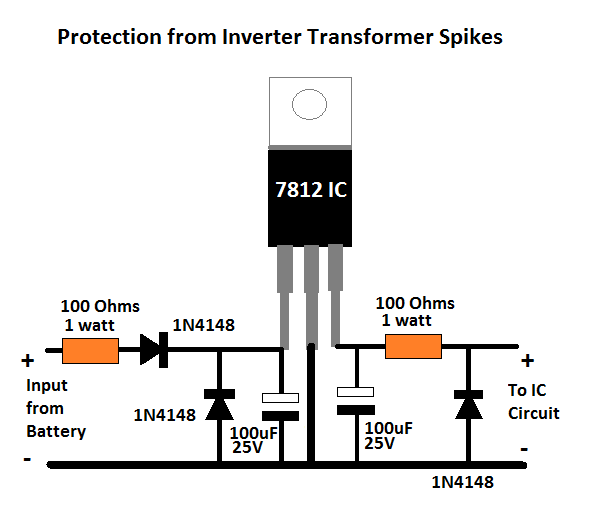
For a 12V application, you can reduce the above spike protection circuit to the following version:
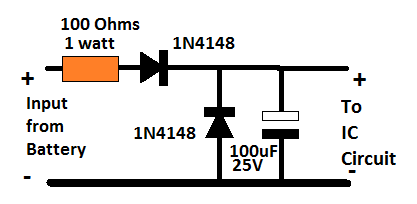
Battery, MOSFET and Transformer Determine the Wattage
We have discussed this many times through different posts that it is the transformer, the battery, and the MOSFET ratings that actually decide how much power an inverter can produce.
We have already talked about the battery calculations in the previous paragraphs, now let's see how the transformer can be calculated for complementing the required power output.
It is actually very simple. Since the voltage is supposed to be 24 V, and power 500 watts, dividing 500 with 24 gives 20.83 amps. Meaning the transformer amp rating must be above 21 amps, preferably up to 25 amps.
However, since we are using the same transformer for both charging and inverter modes, we have to select the voltage in such a way that it suits both the operations optimally.
A 20-0-20 V for the primary side appears to be a good compromise, in fact it is the ideally suited rating for the overall working of the inverter across both the modes.
Since, only one half winding is used for charging the battery, the 20 V RMS rating of the transformer can be used for getting a 20 x 1.41 = 28.2 V peak Dc across the battery with the help of the associated filter capacitor connected across the battery terminals. This voltage will charge the battery at good rate and at the correct speed.
In the inverter mode, when the battery is at around 26 V, will allow the inverter output to be at 24/26 = 220 / Out
Out = 238 V
This looks a healthy output while th battery is optimally charged, and even when the battery drops to 23 V, the output can be expected to sustain a healthy 210V
Calculating MOSFET: MOSFETs basically work like switches that must not burn while switching rated amount of current, and also must not heat up due to increased resistance to switching currents.
To satisfy the above aspects, we have to make sure that the current handling capacity or the ID spec of the MOSFET is well over 25 amps for our 500 watt inverter. Also to prevent high dissipation and inefficient switching the MOSFET's RDSon spec must be as low as possible.
The device shown in the diagram is IRF3205, which has an ID of 110 amp and RDSon of 8 milliohms (0.008 Ohms), which actually looks quite impressive and perfectly suitable for this inverter project.
Parts List
To make the above 500 watt inverter with battery charger, you will need the following bill of materials:
- IC 4047 = 1
- Resistors
- 56K = 1
- 10 ohms = 2
- Capacitor 0.1uF = 1
- Capacitor 4700uF / 50 V = 1 (across the battery terminals)
- MOSFETs IRF3205 = 2
- Diode 20 amp = 1
- Heatsink for the MOSFETs = Large Finned Type
- Blocking Diode Across MOSFETs Drain/Source = 1N5402 (Please connect them across drain/source of each MOSFET for added protection against reverse EMF from the transformer primary. Cathode will go to the drain pin.
- Relay DPDT 40 amp = 2 nos
Upgrading to Modified Sinewave Inverter
The square wave version discussed above can be effectively converted into a modified sinewave 500 watt inverter circuit with much improved output waveform.
For this we use the age old IC 555 and IC 741 combination for manufacturing the intended sine waveform.
The complete circuit with battery charger is given below:
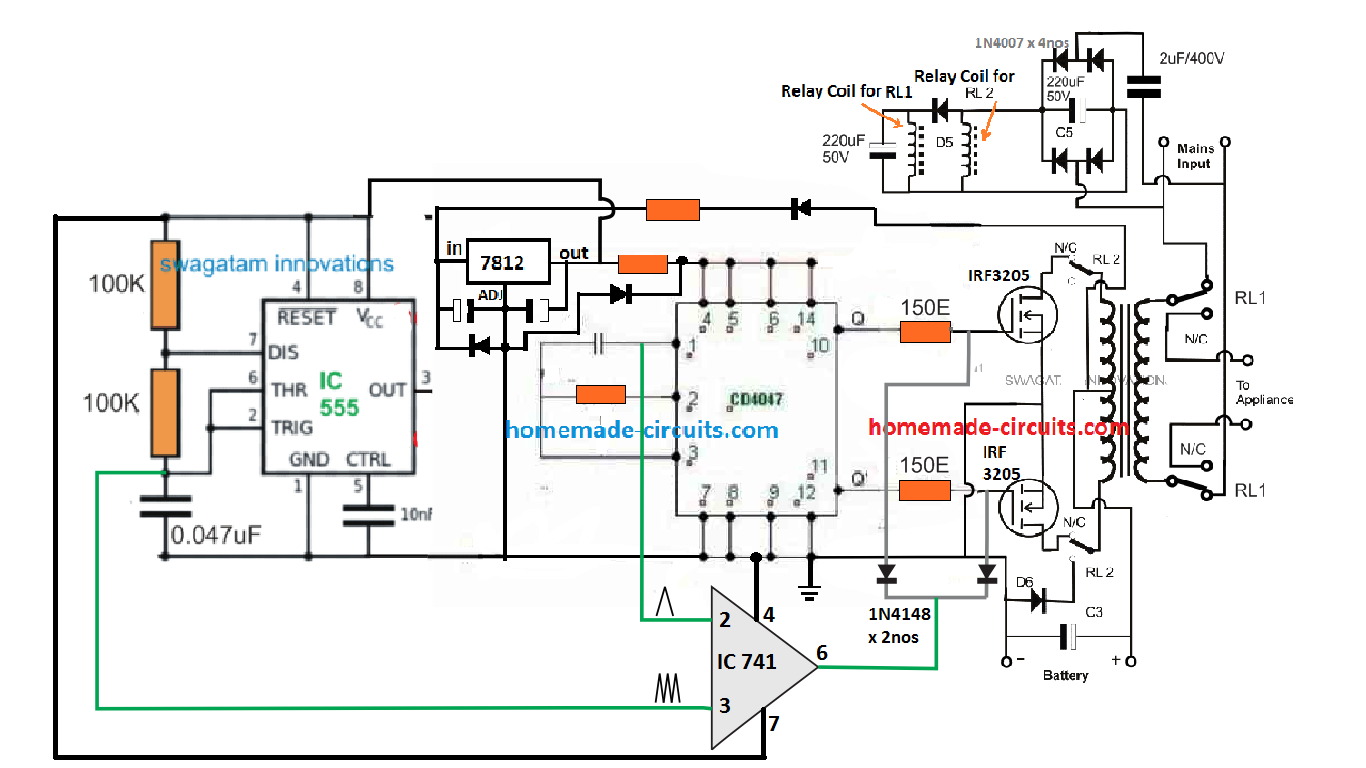
The idea is the same which has been applied in a few of the other sinewave inverter designs in this website. It is to chop the gate of the power MOSFETs with calculated SPWM so that a replicated high current SPWM is oscillated across the push pull winding of the transformer primary.
The IC 741 is used as a comparator which compares two triangle waves across its two inputs. The slow base triangle wave is acquired from the IC 4047 Ct pin, while the fast triangle wave is derived from an external IC 555 astable stage. The result is a calculated SPWM at pin6 of the IC 741. This SPWM is chopped at the gates of the power MOSFETs which is switching by the transformer at the same SPWM frequency.
This results in the secondary side with a pure sinewave output (after some filtration).
Full Bridge Design
The full bridge version for the above concept ca be built using the below given configuration:
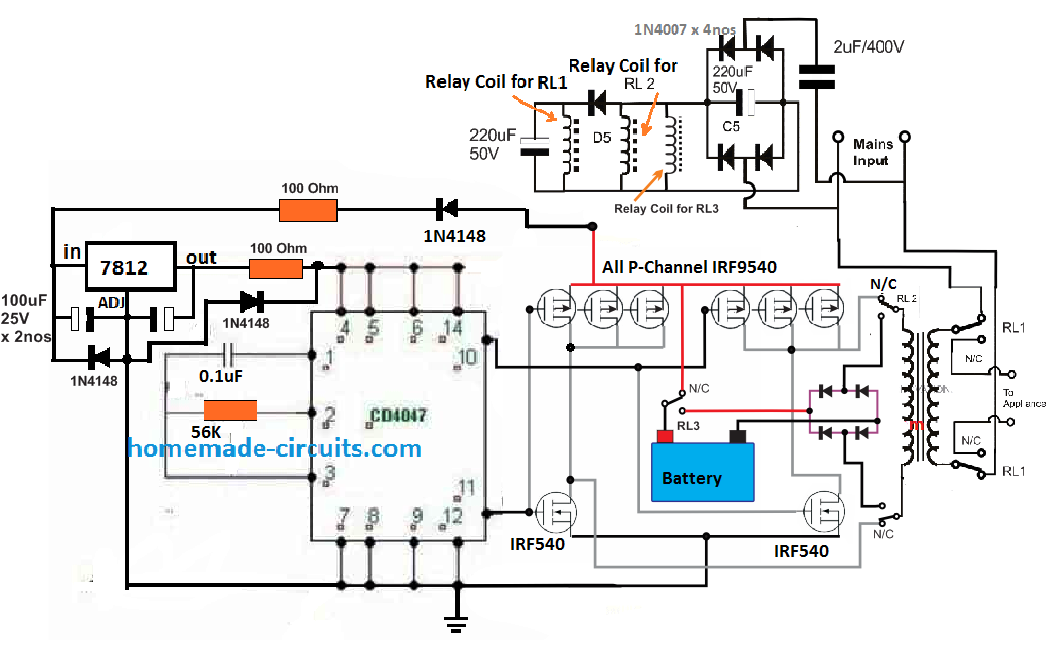
For sake simplicity, an automatic battery cut off is not included, so it is recommend to switched OFF the supply as soon as the battery voltage reaches the full charge level. Or alternatively you may add an appropriately filament bulb in series with the charging positive line of the battery, to ensure a safe charging for the battery.
If you have questions or doubts regarding the above concept, the comment box below is all yours.

Good evening sir, thanks for your reply, let me try it again, hope building/ designing it as shown in the diagram will work straight without adding anything?
No problem Amos, wish you all the best!
Dear Sir,
I had made inverter circuit using CD4047 and IAF540’s as per design given by your website and I succeeded also but, At the moment I connected 12 Volts 7 Ah battery I am getting 200 to 203 volts but it starts to reducing and reached 98 to 103 Volts and after a couple minutes output becomes zero. The components 4047-1no,IRF540-2nos,0.01Mfd-1no,100 Ohms-2 nos,10K Pot-1no,IN4007-2 nos, And when i connect 100nF/440 Volts capacitor at the transformer output it becomes zero so I did not connect 100nF. Please support me to make 500 Watts inverter and use one fan and light.
Hello G. kandasami, the problem that you are getting presently may be due to one of the 3 reasons:
1) Your battery has been destroyed due to heavy use
2) Your battery is not properly charged
3) Your MOSFETs are burned.
When are you seeing this problem, is it with an output load connected or without a load?
If it’s without a load then the reason could be as explained above.
You can replace the MOSFET with 50 amp BJTs and check the response. Because MOSFETs are unpredictable and can burn without indications, a BJT is more reliable.
For 12V 500 watt inverter you will need a 12V 100 Ah battery, a 7 Ah battery will not work.
Good day mr Swag thank for your quick responses to every question asked so far. pls my question thus, is what is the exact diode connected in-between the relay coils.
Thank you Godspower, you can use 1N4007 for the diode.
How many relay used this circuit
2 DPDT relays
Eng. swagatam, you are outstanding in electronics systems, your explanations are clear and easily to understood.
I need your support on how i can build a 5 and 7 kilowatt inverter and battery charging circuit diagram for my home.
you are doing an excellent job, please keep it up.
Hi Jonathan, you can select any small inverter design, and simply upgrade its MOSFETs, transformer and battery to get the desired power output…for a 7kva inverter you may have to go for a 48V battery/transformer or a 60 V battery/trafo, the higher the better, ….also the transformer must be rated to handle the specified amount of current, that is 7000 / 48 = 145 amps
A very big thanks to you swagatam, making out time to reply and explain.
i appreciate, thanks once again.
can i use any of your battery charger diagram to build a battery charger
with cut off circuit for
my generator at home.
i like all of your posts. they are very interesting and educative.
they really are.
can i reach u for personal questions if u don’t mind.
Thank you Jonathan and I am glad you liked my posts!
You can select any of the battery charger circuits which you find the most suitable for your specific application.
You can post your queries here, through comments, i’ll try my best to solve it for you!
Good day sir pls I need a pure diagram of the battery charging inverter. I did not understand some symbols
Please specify which symbols you cannot understand?
The article is very good, I am very interested in the topic of inverters. All the best
Thank you for you feedback, glad you liked the post.
I don’t know , is there anything I should add to the circuit, like regulator or increase the resistance
don’t connect the MOSFEts initially. First test whether your IC 4047 is actually oscillating or not. See the datasheet of the IC here
IC 4047 Datasheet, Pinouts, Application Notes
Good sir, the circuit is nice . But after my design the ic spark and spoiled, plz can u help
Hi Amos, 4047 inverter is very basic inverter, and nothing should go wrong. Please see the small 4047 inverter which I built, in the following article….it is a 200 watt inverter and it worked directly at the first attempt. For the MOSFETs I had used IRF540
https://www.homemade-circuits.com/7-simple-inverter-circuits/
hi,thanks a lot for your circuit.I have two questions. is it regular to connect the circuit to car battery without soft start for mosfets? Do we need RC and a Flyback diode for each gate? and second question is about the value of gate’s resistor. I know how to calculate it but i can’t undrestand why in some circuits designer sets wrong value for example instead of irf3205 they use z44 with 100 ohms resistor for gate while it should
be in the range of 10-20 ohms.
Hi, you are most welcome! yes it is normal to connect the battery without a soft start unless the power is too large. But if you wish you can add a soft start by adding diode capacitor network at the gates of each mosfet.
The gate resistor depends on the frequency of the source. For 50 Hz and 60 Hz, any value between 10 ohm and 100 ohm should not have any problems. Similarly mosfet selection strictly depends on the power rating of the inverter, it has nothing to do with the mosfet number
Hi Swagatam,
I want to ask this: What happens when I use a slightly different transformer for example, instead of 9v 0 9v as specified in the diagram and I use 12v 0 12v?
Or instead of a 12v 0 12v as specified in the diagram and i use a 15v 0 15v transformer or 14v 0 14v transformer?
Hi Joe, at 12V you will get 220V when the battery is 12V, but as the battery drops to 11V, the output voltage may drop to 200V, therefore 9-0-9 is recommended which will give maybe 240V when the battery 12 V, and the output may still continue to be 220V when the battery voltage drops to 11V.
Basically at battery 11V also the output must continue to be above 220V….which means the trafo voltage must be rated lower than the battery voltage
Can I use 7v 0 7v transformer? Will it be too low? I will try and look for 9v 0 9v also?
7-0-7V transformer will work, you can use it…
Can I charge 48 volt battery with 40 volt transformer?
you will need 56V to charge a 48V battery
Is there any way to make a less wattage transformer e.g. 500watt to build inverter of 1000watt.
That’s not possible, 500 watt can never produce a 1000 watt power
Hie Swag, wanted to ask how much complex is it to add automatic cut off of battery charger and if it can be done please show me how. And also does the mains responsible for charging only. Can the solar panels also charge when there’s no grid supply. Lastly is there a display circuit that shows input and output voltage and wattage in figures.
If it can be done im Kindly asking you to do that for me
Thanks.
Hi Binus, first you will have to build and test the solar inverter, once you build it and test it successfully after that we can add the battery charger externally….adding the battery charger is not difficult but making the solar inverter can be difficult.
Ing. espero su respusta ,,,,mis saludos y agradecimientos ,,,,, Pregunto…, En la parte de …… .Actualización a inversor de onda sinusoidal modificada ,, se podría alimentar el circuito con un Regulador de 9 volt (7809) el CD4047,, 555 ,, 741 ya que sus alimentaciones están en rango ,,, SEGUN Datasheet
I am a new learner, Please, how many pin has the relay used in the diagram?
Each of the relays have 8 points, since they are DPDT relays…. Please build the inverter without the relay first, if it works only then go for the relay connections.
Ok thanks. I will do that first
I want to know price of these components.
Ing. mis saludos y agradecimientos,,,,,Pregunto…,En la parte de…….Actualización a inversor de onda sinusoidal modificada,,se podría alimentar el circuito con un Regulador de 9 volt (7809) el CD4047,,555,, 741 ya que sus alimentaciones están en rango,,,SEGUN Datasheet
Sir ,how to put charging input on this inverter for charging the battery.
Raj, it is derived from the transformer itself and the mains input….
Thank you sir
Thanks sir. I am referring to the diagram with battery charger
There are two relays RL1, RL2
Both are DPDT
I have connected the panel to the relay stage. But I don’t seems to know how many relay this diagram has. Kindly help
which circuit are you referring to?
Thank you sir. How many legs does the relay has and how many volt is it. And how many volts is the relay coil
Emmanuel, you can see refer to the following article for all the info:
How a Relay Works – How to Connect N/O, N/C Pins
What do I do if I want to reduce that wattage. I mean instead of 500w I will like to do 200 or even 100watts
reduce the wattage of the battery and the transformer accordingly….
Please sir, whi of the diode is the 20amp
D6, near C3
Thank you for the response sir. What of the D5 because I was thinking the initial one was for D5
D5 is for the relay coil operation which can be just a 1N4148 diode, the 20 amp is for D6
Thank you for your response sir. What of D5.
And in the case of the transformer, is there any alternative to 20-0-20v. I am not able to get that here
Transformer voltage must be lower than the battery voltage, you can try higher values also which will cause proportionate amount of reduction in the output AC
Thank you very much sir. How do I put the indicator for the battery charger in other to know when it’s fully charged.
Can it be charged with solar panel too?
Hi Emanuel, for that you will have to connect an external circuit such as this:
https://www.homemade-circuits.com/battery-full-charge-indicator-circuit/
yes solar charging is also possible, if the panel is rated appropriately
Sir how to connect wire for charging the battery(input current in battery)in shown ckt.
Let’s assume I upgraded my inverter up to 2000w, can I use it to iron my clothes, powering my electric cooker and the likes?
Sure you can….
Dear Swagatam, I want to congratulate you for your admirable work, since today there are few people who offer their knowledge in this professional and disinterested way solely for the purpose of teaching.
Excuse my inconvenience, maybe you can help me with the pcb layout of this inverter with 500w battery charger
Thank you Clarhem, sorry I do not have the PCB details for this project, you can contact any professional PCB designer for the same, they will surely help you out with some charges.
hi Swagatam i would like to know how a ups can be transformed into a 12volt to 240volt inverter, currently when pluged just on battery it goes off automatically in 15 mins, how can i make it on continiuosly with being off automatically in 15 mins with 12volt battery use.
Hi Paul, yes it can be done, by removing all the relay changeover stages and by connecting the load directly across the secondary of the transformer.
Hi sir,I have some questions regarding the above articles.
1. With 56k and 0.1uf capacitor, what is the output frequency?
2. For the h bridge,you haven’t provided the down and how to configure it.
3. Sir can you help upgrade the h bridge to use all N channel mosfets using discrete components and cd4047 as our osciliation and incorporate the spwm as in the above article.
Thanks in advance and look forward to your response.
Hi Evans, the frequency will be approximately 50 Hz, but might need some further adjustments to ensure a precise 50 Hz.
The SPWM configuration procedure will be the same as done for the center tap version. Instead of connecting the op amp output directly with the MOSFeT gates, you can add a BjT stage, and used their bases for the SPWM chopping.
For Nchannel H bridge I have already explained the method for SG3525 circuit, you can apply the same comcept here also.
Sir,what kind of adjustments please? Again sir for h bridge,we got the high side and the lower side,how is the connection of the spwm?
Evans, Adjustment of the 56k resistor or the capacitor value…please build the basic design first after that we will try to solve the SPWM
hi sir i have certain doubts in making an inverter with some specific specification for a certain purpose.It will be really useful if i get a chance to contact you through phone or email please.
Hi jefson, I can discuss only through this platform, and not through telephone or email
Again sir,can I use this inveter to power a refrigerator?
Yes if the output wattage of the inverter is calculated according to the fridge requirement
Sir, help me with the inverter battery automatic charger circuit diagram.
Here’s a suitable link you may try:
https://www.homemade-circuits.com/opamp-low-high-battery-charger/
Dear Sir,
I am looking for a sine wave inverter circuit with 48V/72V to 440VAC ( two individual windings of 0-230 with phase shift capacitors also serves) of 2KVA with a relay (Invertor on mode) on technology transfer basis.
This can be based on arduino/pic/sg3524.
Dear Ravi, Sorry, I do not have the sufficient information regarding the specified inverter design, at this moment.
Good day sir, please what are the requirement for designing a 3000watt inverter.
Hi Felix, for upgrading to higher wattage, you only have to add more MOSFETs in parallel, increase supply voltage to the transformer up to 48 V 70 amps, and battery up to 48 V 500 Ah
Please if one wants to construct a 3kva center tap transformer, what will be the size of the copper wire and the number of turns for 240vs.
Dear Swagatam
Re 500W Inverter with charger.
Thanks for you prompt reply. Whist I appreciate that the schematic has some additional components (for safety purposes) not shown in the List of Parts, please would you advise the values of these components, so that I can incorporate them into the circuit.
Many thanks
Mike
Thank you Mike, the values are already given in the subsequent diagrams:
https://www.homemade-circuits.com/wp-content/uploads/2019/11/spike-protection.png
all the resistors are 1/4 watt 5% CFR, capacitors have voltage rating two times more than the battery voltage.
I’d like to build this inverter (without the battery charger, as I plan on using solar power), but I have a problem tying up the components on the schematic with the List of Parts.
Parts List specifies 3 resistors (10 Ohms X 2 and 56k Ohms X 1), but schematic shows 5. Likewise Parts List specifies 2 (0.1 uF and 4700 uF) capacitors, but schematic shows 3.
Would appreciate clarification on those two issues, otherwise, everything else makes sense.
Cheers
Mike
If the schematic shows some extra parts, there’s no harm in adding those. The parts list suggests the bare minimum parts required for building the basic 500 watt inverter, whereas the schematic shows some extra features for ensuring better safety to the circuit.
Why don’t I get 500W with 12V 100Ah battery? I get 1200W I think. What about hot transistors?
With a 100 Ah lead acid battery you shouldn’t try getting 500 watt from 12 V, if you do, you will end up destroying your battery in sometime. With 1200 watt your will destroy your battery in minutes or seconds.
But with Li-ion it is easily possible.
Thank you very much.
Can I parallel batteries then?
yes you can use batteries in parallel
Sir You have computer ups 500VA OR 600VA CIRCUIT DIAGRAM
Manjunath, sorry I do not have this circuit at this moment.
Can I use a 100Ah inverter battery?
with a 12V battery 100 ah will not produce 500 watts.
but why sir ,VxI = 1200w theortically, but does it depends on effeciency and pf of inverter circuit.
a new 12v 7.2Ah vrla battery does not provide enough power, my 5w ac led bulb running for 1-.5hr and battery voltage goes from 13.2v to10.7. ,
kindly provide exact detail for 200w with required battery ah rating. lead acid
It is because Lead acid batteries are not designed to be discharged at their full Ah rate, they must be discharged at 10% or maximum 20 % of their Ah rate.
You can get more info on this here
Lead Acid Battery Charger Circuits
Can I use 9V battery?
No!
Good morning and thanks for these inverter circuit diagrams. I realized the second circuit (inverter using 24V battery), but anytime i switch of the circuit, at least one transistor IRF3205 will be destroyed. I have replaced the transistor many times but i still have the same problème. I have added diode berween the D and S terminals, but the problem remains.
Thanks
Hello, I have checked the 4047 based inverter using IRF540 mosfets, and it worked perfectly for me with a 100 watt load. There are three basic reasons for a mosfet getting burned. 1) if the mosfet is not original, 2) mosfet does not have basic protections 3) Sudden high current surge across drain and source.
The sudden high current situation can be corrected by initially keeping the center tap of the transformer disconnected from the battery supply. Start by powering the IC circuit first, and confirm the frequency output from the IC. Once the frequency output is confirmed, connect the transformer center tap with the battery DC and you should find the inverter working normally. If still the mosfets burns then most probably the mosfets are not good quality.
Thanks you once more, i think it is the quality of the MOSFET transistors as you said. Because i have done different protection methods without success. I will try with different MOSFET types. Thank you.
Sure, no problem, all the best to you!
Note: sorry i posted this query in wrong topic before so posting here
Hi Sir,
Need your help again. You are very knowledgeable and humble person. This earth needs more like you.
Can u tell how we can check efficiency of inverter in general understanding language without going into theory behind it. I m asking for the reason bcoz i have very old 3055 based desi inverter of 500 watt and it running excellent since 2003. Only thing is missing is battery overcharge protection but most of the time charging renaming off bcoz i have sukam mppt solar charge controller of 17amp with 300w solar panel. I do not want to upgrade it to digital microcontroller based only fur the reason old inverter never gone bad in 17 years. Only problem in these years that i had to re solder wires to some led and amp meter one time only. Please suggest ur valuable input wheather its worth to upgrade it with latest technology digital inverter…
Images
https://1drv.ms/u/s!AkqDWegCTCgviUoXPcC6pEByP6rt?e=H77KIy
And one more question what is the best charging current practice ( at always 10% of battery capacity or can use low charging current. I think slow charging increase the battery life and so i use 5-7amp current only..) in case if powercut is about an hour in 24 hour. Battery i have is microteck 150ah. I understand u will be very busy but will feel happy if u reply with ur valuable input.
Thanks Ram, you can check the efficiency by measuring and comparing the V x I of the input 12V supply side of the inverter and V x I of the output 220V side of the inverter.
Best charging current for all lead acid battery is 10%, reducing below this level is not necessary as it may increase the charging time to 20 hours. But yes it will help to increase the life of the battery.
for auto cut off at 14.2V you can try the following circuit
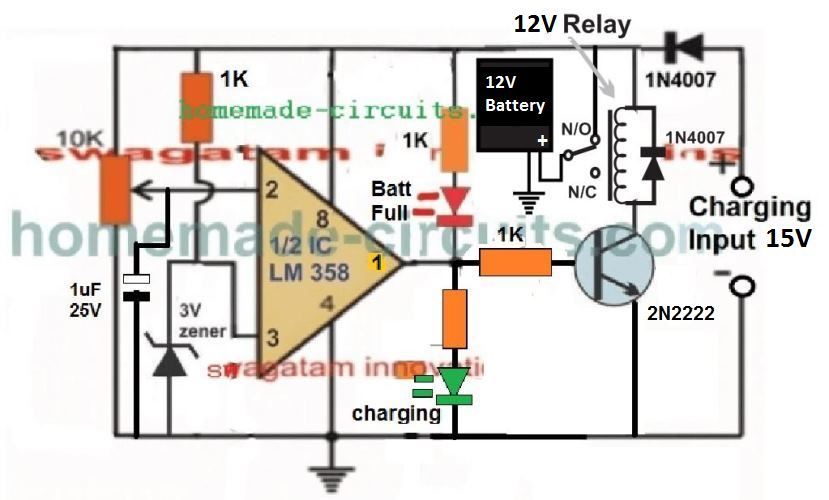
Thank you 🙂
Hi Sir, It’s awesome explanation but I need to know, How we will come to know whether battery charged fully, Is there any led indication?
Thanks
Sidaray
Thanks Sidaray, the simplest way is to add an ammeter in series with the battery positive, when the needle nears the zero volt, it will indicate the battery is fully charged.
Thanks for your good works. Can I add more 3205 mosfets for greater wattage? Thanks
yes you can, it is the MOSFETs, the battery and the transformer that decide the power output.
swagatam sir i want 12v dc 1000w or 1200w power inverter ckt diagrams.
Sree, you can try any inverter design from this website, and upgrade it as per the details presented in this article:
https://www.homemade-circuits.com/upgrading-low-power-inverter-to-high/
Very clean and straight forward project i would like to design, But then how can i add an overload protection to practically work wit this project, Thanks Swagatam.
Thank you, you can add the following concept for overload protection:
https://www.homemade-circuits.com/low-battery-cut-off-and-overload/
Thank you so so much for your reply sir.. Have to finally get a jem in electronic field who solves the problems with efficiency..
You are welcome KGopi
Please I need answers because I wanna couple a 130w solar panel with 650VA UPS, will this work sir
I have request to you sir, pls upload configuration and design of current source inverter
Thank you Amar, I am studying it, and if possible I’ll post a related article soon.
Sir i have 3kw /400v Dc on-grid Solar system… when grid power switches off during peak hours of sunshine ongrid solar also switches off.. so energy from solar system getting wasted…so during this switched off time can we have another solar inverter without battery system to run atleast 2000w power system.. Night i don’t need power
Yes you can use the solar power by diverting it through a relay changeover. This relay should be powered from grid voltage, so while grid is available, the relay contacts keep the external inverter disconnected from the solar power. When the grid fails, the relay contacts switch over and connect the external inverter with the solar panel.
Thank you somuch for your Replay Sir.. without battery can i use solar energy directly .. just by converting to 220v AC from 3kw..400v DC
Hi K Gopi, yes that may be possible if the transformer is correctly designed for converting the 400 V into 220 V
Hi
I need a protection circuit that will keep an appliance switched off during load shedding and only switch on when the power comes back on and is stable at 240v.
Kind regards.
Hi, you can try the concept presented in the following article
https://www.homemade-circuits.com/mains-high-low-voltage-protection/
Hi
Thanks for the reply appreciate it. Our line voltage is 240v and when we have load shedding it switches back on with over 300v. I need a circuit that will switch the appliances back on when the voltage stabilizes at 240v.
Regards
Hi, the linked circuit will do exactly that! It will never switch ON the appliance with the wrong voltage
good evening sir,i would like to know the formulas for calculating ic 4047 frequency
Yusuf, you can refer to this article:
https://www.homemade-circuits.com/ic-4047-datasheet-pinouts-application/
hi sir, can you help me how to make a 500 watts inverter, 12v DC to 220v AC, 60H, and modified square waves? can you make a circuit for me and its layout on pcb?
Hi lloyd, you can try the following concept
https://www.homemade-circuits.com/1500-watt-pwm-sinewave-inverter-circuit/
Hi engineers,I have done this project is good,I even went further ahead by making it an automatic inverter charger. My problem is that my batteries don’t get charged fully since inverters with pwm usually have their transformer voltages halved or 2/3 of the same,any help on how I can improve the charging speed will be appreciated.
Thank you Evans, I have already addressed this issue in the article, under battery MOSFET, transformer selection….
Hello Sir I have 7805ic and IRF 540 mosfet can I use it to make this inverter?
Bios, 7805 will not work, you will have to use 7812, IRF540 can be tried, it might work, but mount them on large heatsinks
can I have the layout in Pcb of the modified sine wave inverter circuit?
and what is the orange one in the circuit represents?
I’ve been looking at various inverter circuit designs on the ‘net and youtube. You have done a very good job explaining your circuits and detailing how they work. As you know power inverters can be pricey for anything 500 watts and above, so your designs now seem obtainable to actually making my own.
What would be required to build a 2000w or 5000w power inverters? Does your circuit design change?
How would you go about calculating the components specs for a these higher wattage inverters?
Thank you for posting your circuits and your comprehensive yet well written explanation.
-Martin
Glad you liked it, I have explained the process of calculating the transformer and the MOSfET for upgrading the inverter to any desired power level.
I really appreciate this effort.
Am new in this website and am always looking forward to understanding how a smps circuit oscillates, cause am a 17yr old beginner in electronics
Thank you, I appreciate your interest…keep up the good work
excellent design
Hi,I like the design. What can be done to the circuit so that I can use a two wire transformer at the primary side and also instead of using the relays I just use the same mosfets for inverter and battery charging? I’ll appreciate a schematic diagram if possible.
Hi, I’ll try to update it soon
Will appreciate
Hello sir swagatam,how did it go,did you find anything good for an update about an inverter circuit diagram using a transformer without centre tap?
Hi Evans, I have updated a full bridge version at the end of the post. You can check it out…
Sir pls upload current source inverter circuit and design configuration of it.
I will surely try…
Thank you sir for your kindness,now my other questions are;
1. Can we use N channel mosfets only with the same circuit,any update please? Coz with high currents, I will be forced to use a big number of p channel mosfets which Leeds to high cost and space limitations.
2. What could be the current ratings of RL 2 & RL 3 if for instance I built a 24vdc/220vac/6000w inverter?
Evans, N-channel cannot be used without specialized ICs or a bootstrapping network
Thank you sir for your response. So if I integrate a boostraping network then can use cd4047 as the oscillator? True or not? Any clarifications?
It is possible with bootstrapping introduced with any oscillator.
Sorry had a typing error,I meant cd4047
Is 24v battery is available
I liked the circuit. I only wish it had a power supply for its regulation both in frequency and in output voltage. Thank you very much
Thank you, if possible I’ll try to update the details in the article.
hi dear Mr Swagatam
i prepare circuit contains 4047 and 3205 and 500watt transformer test with 12 volt adapter 3A is and 9 watt load OK but connecting it to battery causes MOSFET connected to pin 10 of 4047 (via) 10 ohm without load broken . please inform me what is wrong.
bet regards ; KHORAM RIYAHI
Hi Khoram, it could be due to high current reverse spike from the transformer.
Please go through the following article, and try to include all the measures that is indicated in all the single MOSFET diagrams.
https://www.homemade-circuits.com/mosfet-protection-basics-explained-is/
Also for the IC 4047 did you apply the mentioned protections. Make sure to apply at least the following:
https://www.homemade-circuits.com/wp-content/uploads/2019/11/spike-protection-1.png
Dear Swagatam
is there any limitation for battery power cable and power line because of transformer harmonic radiation.
best regards
riyahi
Hello Riyahi, I am sorry, I have not yet investigated this issue, so not sure about the facts!
hello Mr Swagatam :
i designed a 12-012 to 220 volt (500 w) for inverter but practically it is 12-0-11.5 volt has it any effect on 3205 mosfet
thanks very match. riyahi
Hello riyahi, the difference in voltage across the transformer winding will have no effect on the mosfet behavior. You can use it safely…
Pls sir can u give me the pure diagram of the inverter with battery charging. Pls dont use symbols I didn’t understand it well
Hello is the 2nd last circuit in this article best to use in my shop as backup when there is a power grid failure? Two, can I u irf3205 being it’s an inverter charger? Thanks
You can use it but only if you have understood the design perfectly.You can use IRF3205 for the inverter
And can I use two 4 irf3205 or 2 are just enough for the the 500w inverter charger?
I think 4 will be better, 2 on each side, and mounted on large heatsinks. Make sure to put protection diodes across darin/source of the parallel mosfets. One common diode across each parallel set will be enough.
Ok sir. Now with 2nd last modified inverter sine wave inverter charger in this article. If u compare it with the second circuit in your 7 modified sine wave inverter in the other article which one is best and efficient I can use in my shop?
The second last circuit above is more efficient but more complex to build.
Ok sir, but as an expert in this field if I avoid the charger part of this circuit in ths article as use it as an inverter alone. It still stands the best compared to the first two circuits in the 7 modified sine wave inverter? Advise sir, I want to pick one. Thanks in advance.
Morris, yes the second last circuit is more efficient but you will require an oscilloscope for testing the waveform. In the 7 modified article, a oscilloscope may not be required.
Sir I don’t have oscilloscope in my shop. Can i jst use it pliz or switch to the first two circuit in the 7 modified sine wave inverter? Advise
Without an oscilloscope it is not possible to complete the second last design, in that you case you can build the second design from the 7 modified article. Make sure to check the video to see the waveform details.
So if I make it the way it is to charge the battery I still need an oscilloscope to verify its vave form?
oscilloscope has nothing to do with battery charging, the scope is needed only to verify the inverter output waveform
Ok sir. Let me just build it and use it in my shop as more efficient one as you told me. Hope it will perform well. Thank u very much
Sure, no problem.
Hello my lecturer, I just want u to help me abit on the inverter circuit. My customer brought me an inverter charger 800 VA and it’s motherboard is completely damaged. Can u refer me to one of your sine wave inverter charger that I can replace with it pliz. 12v 800VA I beg
Hello Morris, most of the inverters circuits explained in this blog use center tap transformer which cannot be replaced with the mother board of your inverter, unless your inverter is also a center tap type.
Ok my transformer is a center tap wire can I use the second last modified sine wave circuit and use 8 mosfet output to match the transformer size and get the best output wattage or that 800VA
Yes you can do that, but build it step wise. First build the basic inverter, test and confirm, then add the sine wave section, test and confirm and then finally build the battery charger stage, again test and confirm. You will need an oscilloscope for all this.
But sir i don’t an oscilloscope, if build it the way u drew it as I can see without that oscilloscope will it work? Secondly, if not can I use the the second circuit in your 7 modified sine wave inverter and use the 8 MOSFETs to get the equivalent 800VA. The inverter is luminous 12v 800va from India. Advise
Without oscilloscope how will you test the waveforms?….please do not build without an oscilloscope.
Thanks for your response sir, I appreciate a lot how u advise. Lastly, in this post the last circuit using transformer without center tap wire is it also a modified sine wave inverter at just an ordinary but does that require an oscilloscope to verify its output wave form? That’s all I have sir thanks in advance.
You are welcome Morris, the last circuit is an ordinary square wave inverter not a modified one. Oscilloscope is recommended for all inverters, to ensure that the waveform is correctly verified.
And is the second circuit in the 7 modified sine wave inverter good to use if I use 8 output MOSFETs to match the size of the transformer and get altleast 800va or equivalent the i look for a separate charge? Advice I beg. Thanks.
yes the second circuit is good, will give you a decent modified sine wave which is quite equal to a pure sine wave. Commercial inverters never use center tap transformer for their inverter designs, as far as I know.
Ok sir. So for the lighting and tv’s it will work perfectly…the second modified sine wave inverter? So I will use 10pcs if MOSFETs…….the ones in ths damaged motherboard (55nf06)? Many thanks sir.
You will have to connect a few 1uF/400V capacitors at the output of the transformer to get a pure sine wave like response which will suit most equipment. You can use 10 mosfets in parallel on ech channel.